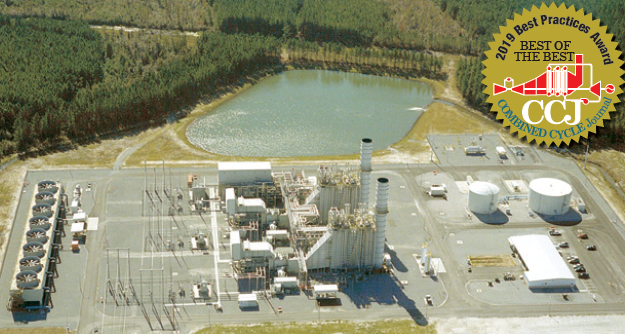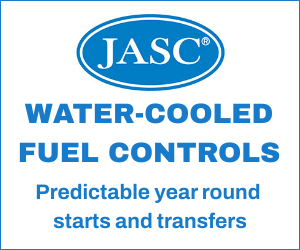
Effingham County Power, owned by The Carlyle Group and operated by Cogentrix Energy Power Management, is a 525-MW plant in Rincon, Ga, equipped with a 2 × 1 combined cycle. General manager is Bob Kulbacki.
Reduce imbalance and variance charges with consistent plant operation
Effingham County Power was awarded one of the eight Best of the Best awards presented in 2019, bringing its total to seven since 2010. No other plant has received more than five. What’s particularly noteworthy about Effingham’s run is that it has spanned three owners, four plant managers, and several teams of judges. The only common denominators are ties to its former operator, CAMS—Consolidated Asset Management Services, and an empowered staff that embraces a process of continuous improvement.
Effingham’s owner back in 2010 was Progress Energy Ventures, then came ArcLight Capital Partners (with minority partners GE Energy Financial and the Government of Singapore), and now The Carlyle Group.
Plant managers over the last 10 years: Eric Garrett, today Senior VP Operations for CAMS; Ken Earl, now VP Operations for eastern plants in the CAMS portfolio; Nick Bohl, currently the CAMS plant manager for Competitive Power Ventures’ (CPV) St. Charles Energy Center, a 2 × 1 combined cycle powered by 7F.05 engines; and the incumbent, Bob Kulbacki.
The first of Effingham’s 2019 best practices shared in this issue of CCJ ONsite follows:
During commissioning of Effingham County Power, procedures were developed for hot, warm, and cold starts based on steam-turbine first-stage metal temperature. Suggested generation tags were provided to the plant along with the startup procedures.
Over the years, staff learned the generation tags didn’t apply to the entire temperature range of the three types of starts. For example, the temperature range for warm starts extends from 450F to 750F. The amount of time to start up is affected by temperature and if an improper generation tag has been approved, the plant could incur imbalance and variance charges.
Because warm and cold starts are not performed frequently at Effingham, personnel wanted to develop a template for conducting these startups—one that would ensure repeatability and contribute to lower costs. Reducing startup costs is a priority at merchant plants like Effingham. This can be done by reducing startup time, thereby saving gas and the amount of ramp energy sold to off-takers.
Having several established ramp profiles for the starts performed allow for the operators to submit accurate daily status information to the trading floor. The ramp profiles also can be provided to off-takers when developing power contracts so they are aware of the plant’s different startup scenarios.
Another issue encountered was how various conditions affected hot starts, which Effingham performs about 95% of the time. These conditions included executing a hot start with a depressurized HRSG, a cold HRSG following maintenance, and an extended amount of time between hot starts. Staff found that using the same ramps for these different conditions could lead to imbalance and variance costs or improper warming of a cold HRSG.
Since warm and cold starts are performed infrequently, staff knew it would be a long process to develop accurate ramps for various temperatures. A log sheet was developed which listed the type of start, amount of time in shutdown, and the steam-turbine first-stage metal temperature. Along with these data, the operators were tasked with listing the time they performed crucial steps of the startup.
Ramps used for the startup were recorded along with recommended ramps for the next start. The operators also listed any lesson learned during their startup so that the issue could be avoided during the next time.
All the data sheets were reviewed and saved on the shared drive for each operator to review prior to performing a non-routine start. After several startups with similar start conditions had been performed, staff developed a guide with times for all operators to use and fine-tune. The leadership team continued to review the non-routine starts and once the goal of reducing startup time and imbalance charges was achieved, these ramps were published on a spreadsheet and provided to the applicable groups associated with generating and selling power for the plant.
In documenting starts versus start temperatures, staff was able to develop several warm ramps that were applicable to a wide temperature range. With this information, the Effingham team developed lower-, middle-, and upper-range ramps which were useful for the complete warm-start range. Ramps also were developed for hot starts with a cold HRSG, since the starts differed when a cold HRSG was involved.
This project spanned several years and is re-evaluated each time a non-routine start is performed. The ramps developed have benefitted management and operators involved in providing plant-specific data to outside organizations. Effingham is responsible for submitting a daily status to traders, which includes ambient temperatures, maximum generation, and the startup ramps.
Most of the plant’s starts are hot and the ramps don’t vary with the short shutdown time. As the amount of time the plant is offline increases, the steam-turbine first-stage metal temperature decreases more. This requires adjustment of start ramps to assure the plant is warmed up within established thermal limits.
Having the required data available in a convenient spreadsheet allows for Effingham to provide requested ramps quickly when called by the traders or corporate engineering. An additional benefit of this project has been more consistent plant operation because of the guidelines provided operators for non-routine starts.
The result: Imbalance and variance charges have decreased while performing plant starts in accordance with procedures developed in-house.
Learn more from our Best Practices Awards sponsor
Don’t forget to verify the ability of HRSG feet to slide
There was a very audible popping sound emanating from Effingham County Power’s HRSGs during unit startup. The cause: Binding of the units’ grease-starved sliding feet during casing expansion. The sliding feet are 40 × 18 in. and they had only two grease zerk fittings—one per side of the webbing in the center of the foot.
The absence of machined passageways to transfer the grease to the outermost areas of the bearing pad was the root cause of the issue. After years of cycling and the extreme pressure exerted on the bearing pads, the grease had formed its path of least resistance: It remains in the center of the sliding feet, forcing about 90% of the bearing-pad surface to be metal-on-metal. Thus, the feet are not able to slide freely while the HRSG expands and contracts.
Once the HRSG begins to grow thermally, pressure is exerted on the sliding feet causing them to bind. When the pressure is high enough to cause the sliding feet to move, a loud noise results and HRSG components are subjected to mechanical shock.
The first corrective action: Remove any trapped grease from under the feet. The thought was that if there was old hardened grease in this area, it could be blocking the addition of fresh grease to the feet. The plant used a pressure washer to remove the grease which was collected and disposed of properly. However, after adding fresh grease, the noise was still present after startup.
Staff contacted the HRSG OEM to obtain drawings of the sliding feet to verify if the undersides of the feet were channeled or flat. After discussions with the vendor, it was determined that adding more zerc fittings to the feet was the best solution for the problem. The feet located between the stationary support and the turbine were the first to be modified because this section had the highest growth rate of all the HRSG sections.
Two holes were drilled and tapped into the HRSG feet and zerc fittings were installed. The new holes are located in the far corners of the feet, off-center of the existing zerc fittings. This new configuration has a zerc fitting on all four sides of the sliding feet. With four zerc fittings, the grease is distributed throughout the bearing pads allowing proper lubrication.
The benefit of this best practice is that the sliding feet are operating properly. Since the new zerc fittings have been installed, and grease is being distributed to the entire bearing surface, the popping sound following startup has not been heard. By decreasing the stress on the HRSG and letting it grow as designed, Effingham will save a substantial amount of money in weld repairs—and likely extend the lives of its boilers.
Fans extend the lives of HRSG lower penetration seals
Effingham County Power was replacing failed penetration seals in the floors of its heat-recovery steam generators (HRSGs) about annually. The plant’s two HRSGs are arranged with two headers, each serving four seals. Replacement of the plant’s 16 seals costs about $100,000 in materials and labor.
During each overhaul, cracks were discovered adjacent to the seals. No one could determine if the cracks were caused by the failed seals or if the cracks caused the seals to fail. Certified welders were brought to repair the HRSG casings before replacing the seals—at an additional cost of $50,000 to $75,000 depending on how extensive the cracks were.
After the 2018 spring outage, new penetration seals were installed and the HRSG casings were repaired. The seals replaced had failed after only about 500 hours of service—cause unknown. Supplier of the penetration seals sent technicians to inspect and replace the damaged components. They determined that the premature seal failures were caused by casing cracks blowing hot flue gas onto the seals.
Investigation revealed casing insulation had deteriorated, exposing the metal to gas-turbine exhaust gas. This caused the HRSG floor to buckle, warp, and crack, allowing the gas to escape and damage the lower seals and the casing. The temperature around the seals was roughly 850F; the maximum design temperature for the external side of the seals was only 700F.
In April 2018, Effingham installed three external blowers and associated ductwork on each HRSG to provide cooling air to the seal area. The cost of the three blowers and ducting to the seals was $1600 per HRSG. The blowers are driven by 120-Vac motors that are plugged into a plant receptacle. The auxiliary operator verifies the blowers are in service prior to the plant startup. He also checks that the blowers are running during rounds; the fans are de-energized when steam is no longer in the HRSGs.
The plant established a PM to check temperatures in the area of the seals weekly. A spreadsheet was developed to track the temperature scans, which are reviewed to verify the integrity of the seals.
After the installation of the blowers and ducting, the area under the HRSG is cooler allowing personnel access to the blowers and seals. The seals are easy to inspect and to determine if they are starting to fail by observing any color changes in the seals’ outer material.
There was a forced maintenance outage to repair the HRSG casing and replace the damaged seals. Several engineers inspected the area and determined excessive heat had damaged the HRSG casing and that it had to be replaced. Several vendors were contacted to bid on the replacement.
The blowers and ductwork reduced the temperature in the seal area by 250 to 300 deg F. While the blowers have been in service for only a year, they have extended the lives of the lower seals. This allowed plant dispatch through the critical summer run season, increasing Effingham’s bottom line.
Casing replacement and new lower penetration seals are scheduled. After all work is complete the blowers and ducting will be reinstalled and operated to extend casing life.
Logic change increases gas-turbine reliability
Effingham County Power’s two gas turbines were supplied with a single duct-pressure transmitter for information only; exhaust-duct pressure was protected by three hardwired switches. One switch was arranged to alarm on the control-system HMI when its set point was exceeded. Set points for the other two switches were set to provide a trip signal to the control system. If two out of three set points were exceeded, the unit would trip.
Since the trips typically occur when the unit is fully loaded, possible mechanical damage can occur. Also, there can be significant monetary cost to the plant because of the loss of generation from this event.
Staff discovered the pressure-switch set points would drift because of gas-turbine vibration and changes in ambient conditions. In 2016, the plant experienced several GT trips because of high pressure in the exhaust duct. After each trip and prior to restart, the switch set points were checked; in all cases they required adjustment to the correct value.
The plant’s short-term solution was to change the tubing to all three switches to allow checking of the set points with the unit online or offline. The increase in frequency of checking the set points helped to increase the unit’s reliability.
There was little time for the operator to take action when the set point was exceeded until the trip signal was received. This was observed several times when there were storms in the area causing changes in ambient pressure. Based on this observation, controls engineers were asked to add feedback logic to the system that would allow the GT to reduce exhaust-duct pressure by reducing load automatically without initiating a unit trip.
Staff discussed the Effingham plan with the GT and HRSG OEMs and determined the maximum allowable exhaust-duct pressure to prevent component damage. Once this value was determined, runback and alarm set point values were selected.
A third-party controls engineer was engaged to review the plan and design the necessary logic. The only way this change could work was to swap out the pressure switches with transmitters, which was done by plant personnel during the fall maintenance outage.
Once the control-system logic change was made and tested, the units were dispatched; no issues were encountered. Transmitter outputs are displayed on the HMI control screens for operators to monitor when the units are online.
There have been several instances this past year in which the plant has been operating at the alarm set point with the units not in baseload service. In an attempt to maximize output, the load was increased. This increased exhaust-duct pressure, with the runback set point and the control system reacting as designed and reducing the unit load below the set point.
Effingham is charged $150/MW for lost generation. Typically, the unit trips when fully loaded which results in a financial penalty of approximately $15,000 per occurrence. Total cost of replacing the switches with transmitters and the logic change was $13,500. In 2016 the plant tripped three times on high exhaust-duct pressure. Since the logic change was implemented, it has not tripped on high exhaust pressure.
Land application: A practical way to dispose of cooling-tower blowdown
Effingham County Power’s evaporative cooling tower blows down its high-conductivity water into a 2-million-gal holding pond. This water then is sprayed on land in the area of the plant in accordance with Georgia Dept of Natural Resources operating guidelines. The system has five Bermad 720-55 control valves, each serving a different irrigation zone. Valve operation is controlled by programmed logic to ensure the system operates within permit limits.
The valves had recurring issues related to the clogging of sensing and control lines with algae and sediment. Adding to the challenge, the valves are located in underground vaults usually filled with at least 5 ft of water because of the wet environment.
By design, this style of control valve receives system pressure at the top of its diaphragm, which fully closes the valve. The fouling problem arises because the line that closes the valve deadheads at the top of the diaphragm and over time and mud and algae accumulate in low flow areas conducive to plugging.
When an operator finds a zone is not operating correctly, he/she has to isolate the zone and flush the lines manually from an available above-ground source. This ultimately does not completely flush the system because of its location and design.
Effingham’s solution was to pump down each vault, then detach sensing and control lines and free-up the blockages. Next, install a new line on the top of the valve, above the diaphragm, and run it up and out of the control-valve vault. A ball valve was added for manual flushing, which was added to the existing monthly PM tasks for the system. All work was performed by plant personnel.
The operators reported increased system pressure after completion of the modification, indicating the zones not in service were fully closed. Operators also walk down the system during operation to confirm all zones are working correctly. This means individual zone discharge limits can’t be exceeded because of malfunctioning control valves.
The zones have not required flushing outside the normal monthly PM schedule since implementing the best practice. This has contributed to more-reliable operation of the land-application spray system and eliminated the labor required for periodic manual flushing of the five zones.
Chemical unloading checklists help avoid accidents
Almost every type of plant that receives, stores, and uses chemicals has procedures for checking in and transferring the products to onsite storage. The reality is the procedures often are on a shelf or a shared drive. Typically, they are lengthy documents that don’t get printed or carried into the field when operators are multi-tasking.
There have been several incidents in which the delivery truck was connected to the incorrect storage tank or improperly lined-up for the unloading process. If the wrong combination of chemicals is mixed together the result can be an unsafe situation for personnel at the plant and the nearby community.
Since deliveries to the plant can happen at any time, at Effingham County Power the auxiliary operator is the individual generally assigned to monitor the unloading process. Once the tanker truck arrives onsite, there is a limited amount of time to unload the chemical before incurring additional costs. Therefore, it’s important that the operator report to the unloading area, brief the driver, and verify the chemical and the line-up are correct.
To ensure the unloading evolution is performed safely and correctly, an approved checklist should be used as guidance. The checklists are saved on the company’s shared drive for easy access. It takes time to retrieve the checklist and report to the unloading area. Drivers are prevented from starting the process, possibly leading to additional costs.
Both plant management and operations recognized a need for a better and safer process. The solution was to preprint chemical unloading checklists and keep them at the chemical offloading areas in a weather-proof container.
With this improvement, the correct checklist is available at the point of delivery. It includes both verification of product and destination; also, pre-transfer equipment checks for both transfer equipment and safety equipment—such as wheel chocks and safety showers.
Once all the checks are complete, the auxiliary operator and truck driver sign the checklist to acknowledge all checks have been performed and it is safe to commence the chemical transfer. Once the transfer is completed and the truck has departed the site, the checklist is attached to the all the paperwork associated with that chemical. If there is an issue with the evolution, the names of all involved with the transfer are available to conduct an investigation.
The preprinted checklists have been popular and successful. The plant operators don’t have to scramble to find the paperwork. The checklists include all pre-delivery checks and notifications necessary to meet the procedural requirements and assure safe chemical transfer.
By having the driver and auxiliary operator sign the checklists, there is an added insurance that they are performing the evolution correctly. Since having these checklists at the unloading areas, the amount of time that the delivery trucks are onsite has been reduced. Implementing these checklists and storing them at the unloading areas has resulted in no safety observations being discovered during transfers.










